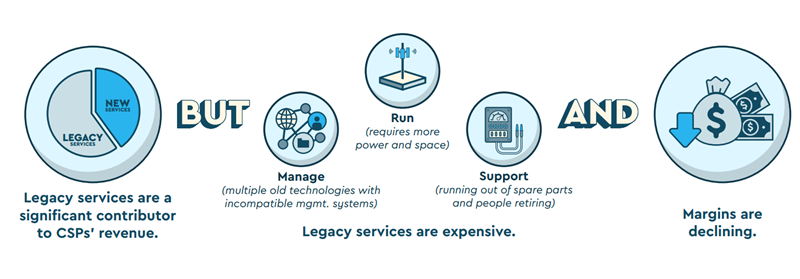Legacy TDM migration: Creating certainty out of uncertainty when transitioning to modern networks
 Chris Antlitz is a principal analyst in TBR’s Telecom Practice. Chris oversees and contributes to the Telecom Practice’s syndicated research portfolio and custom project work. He leverages over 14 years of analytical experience to lead the Telecom Practice’s research agenda as well as provide critical insight and analysis to syndicated and project work.
Chris Antlitz is a principal analyst in TBR’s Telecom Practice. Chris oversees and contributes to the Telecom Practice’s syndicated research portfolio and custom project work. He leverages over 14 years of analytical experience to lead the Telecom Practice’s research agenda as well as provide critical insight and analysis to syndicated and project work.
Chris covers the global telecom vendor and operator ecosystem and all major trends in the space including, but not limited to, developments in NFV, SDN, edge computing, digital transformation, IoT, private cellular networks and 5G. He also covers the hyperscaler market, particularly the pursuits of the Big Nine hyperscaler companies (i.e., Alphabet, Amazon, Apple, Meta, Microsoft, Rakuten, Alibaba, Baidu and Tencent) in the digital space.
This is the third post in a blog series. See Chris's other posts on transformed optical infrastructure, crossing the chasm from legacy to modern networks, navigating vendor equipment swaps, and the 6 attributes to look for when selecting a transformation partner.
Legacy network services, such as time-division multiplexing (TDM), continue to support critical functions and represent significant revenue for communication service providers (CSPs), but margins remain under constant pressure as the cost of running, managing and maintaining these systems continues to increase. The risk of service downtime and feature competitiveness also pose a challenge to CSPs, especially as new, more cost-efficient and feature-rich technological alternatives exist for providing connectivity and managing the network.
Key risks and challenges of operating legacy network systems:

Most CSP networks are an amalgamation of legacy and modern infrastructure (typically provided by a broad range of vendors). These networks have been added to and evolved over decades and tend to always be in some stage of a technology transition. This is inefficient, but a reality when dealing with technology, which is subject to constant innovation and change. CSPs are increasingly leveraging trusted partners to help them tackle the complexities associated with these technology transitions and realize the benefits of modern systems.
 In a recent real-world example, a Tier 1 CSP with extensive wireless and fixed operations in Europe was wrestling with the challenges associated with a large-scale technology migration. Specifically, the CSP was using a legacy TDM network to backhaul traffic from its 2G and 3G cell sites to its mobile core. The network was working fine but was becoming more costly to operate and maintain as the system aged. The legacy system was also inflexible and unable to adapt to new market needs in a cost-effective manner.
In a recent real-world example, a Tier 1 CSP with extensive wireless and fixed operations in Europe was wrestling with the challenges associated with a large-scale technology migration. Specifically, the CSP was using a legacy TDM network to backhaul traffic from its 2G and 3G cell sites to its mobile core. The network was working fine but was becoming more costly to operate and maintain as the system aged. The legacy system was also inflexible and unable to adapt to new market needs in a cost-effective manner.
Due to the critical nature of ensuring mobile phone service uptime, the CSP needed to ensure the traffic flowing over the TDM network would not be impacted by the transition to a new transport system. The solution also needed to be able to support both legacy TDM services and next-generation mobile services (4G and 5G) concurrently. In addition to upgrading the infrastructure, the CSP wanted a modern network management platform implemented that would provide greater visibility into the network, with a single-pane-of-glass view of traffic flows, and more control over the operations of the end-to-end system.
The solution had significant requirements and was a risky proposition, prompting the CSP to look for a trusted partner that not only had extensive experience with these types of network transformation projects (including broad and deep expertise with multivendor environments) but also could take on the full burden and responsibility of ensuring outcome success.
The CSP chose Ciena for the job. The selection of Ciena was an easy decision since both companies had a long-standing relationship pertaining to network infrastructure services and Ciena had a proven track record providing consulting services and infrastructure solutions to help the CSP stay ahead of the fast-growing traffic demand curve.
These types of network migration projects start with the creation of a comprehensive business plan, which includes the architectural design of the new system, the end-to-end workflow process moving from current to end-state system, and the expected KPIs of the end-state system, such as quantifying the opex and capex savings. Ciena worked with the operator’s network team to provide all this information to the CSP’s senior management team before commencing the fieldwork.
For the duration of the project, care was taken to ensure a seamless transition of the traffic from the TDM network to the new system, based on Ciena’s 6500 Packet Transport System (PTS) and Manage, Control and Plan (MCP) domain controller for the unified, single-pane-of-glass view. Ciena handled the entire project end to end, providing the full scope of services as well as the modern network infrastructure hardware and software. The vendor’s tools, processes and people were integral to the success of this complex project, providing peace of mind to the customer that the end-to-end project could be delivered successfully by a single business partner.
Upon project completion, all the major objectives outlined at the project outset were achieved on time and within budget, with zero downtime and at the desired quality of service (QoS). The modernized system also yielded the CSP lower operational risk, greater flexibility to implement new technologies over time (future-proofed), and significant cost reduction compared to the legacy system.
Key benefits of the transformed system:

Nearly all CSPs at some point face the daunting task of how to handle technology transitions without overburdening their internal resources, impacting service continuity, and experiencing cost unknowns. These challenges pose a high risk to business operations and stakeholders, and require careful oversight by management to ensure favorable outcomes. Fortunately, there are trusted partners that CSPs can rely on that bring years of experience and proven methodologies for tackling complex network transformation projects.
Transitioning to new technology doesn’t have to be a headache.


